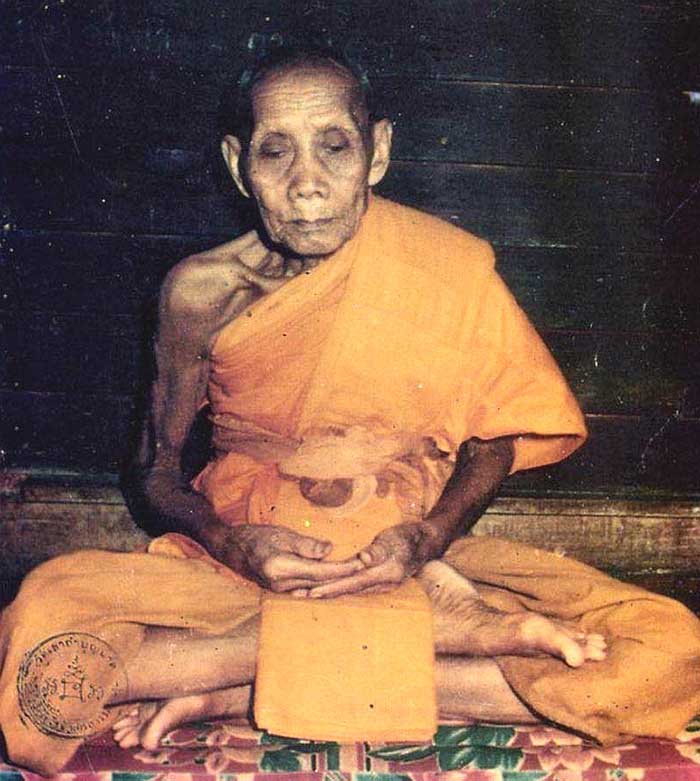Luang Pu Si Chantasiri – The 128-Year-Old Forest Monk of Seven Reigns
Wat Khao Tham Boonnak, Takhli District, Nakhon Sawan Province
Luang Pu Si Chantasiri, a revered monk who lived through seven reigns of Thai kings, is one of the most remarkable and spiritually accomplished monks in modern Thai Buddhist history.
Born in 1850 (BE 2392) in Surin Province, he lived for 128 years and became known for his austere practice, supernatural experiences, and the extraordinary impact of his amulets and spiritual blessings.
From Warrior to Wanderer
Before ordaining, Luang Pu Si led an intense worldly life. He was once a soldier and later a buffalo and cattle trader operating in the forested regions of central Thailand, particularly in what is now Takhli, Nakhon Sawan. Fierce, fearless, and independent, he lived as a hunter and was widely known for his toughness.
However, worldly life eventually became hollow for him. At the age of 39, he chose to ordain at Wat Ban Sao, in what is now Ban Mi District, Lopburi. After just five days in robes, he left for the forests—beginning his lifelong journey of solitary practice, staying in remote caves and undertaking arduous tudong (wandering ascetic) journeys across Thailand, Laos, Burma, and even India.
Miraculous Encounters and Timeless Energy
His forest travels were filled with mystical encounters. On one occasion, after getting lost in the jungle for seven days without food, he was visited by a wild elephant who brought him lotus roots and sugarcane. Another time, deep in the northern jungles, he met a mysterious couple consuming what they claimed was an "elixir of longevity." They gave him the last drops left on leaves.
He later attributed his robust health and extraordinary lifespan to that very medicine—believed by many to have been given by divine beings.
In the Burmese jungles, he once encountered a herd of wild elephants, but rather than attacking, they knelt before him in reverence and led him out of the forest safely. These events became part of the oral tradition surrounding his life and spiritual mastery.
Wisdom Recognized by Other Great Monks
Luang Pu Si’s reputation was such that even great monks like Luang Pu Waen of Doi Mae Pang spoke of him with reverence. When devotees from Takhli visited Luang Pu Waen to request amulets, he told them, “Why come so far? The true diamond is already in your hometown—Luang Pu Si.”
Likewise, he had close spiritual exchanges with Luang Pu Suk of Wat Pak Khlong Makham Thao, sharing similar wicha (magical practices), such as teleportation, empowerment of leaves, and energetic protection. The two would address each other as “Luang Phi” and “Luang Nong” (elder and younger brothers) with deep mutual respect.
Arrival at Wat Khao Tham Boonnak
In BE 2512 (1969), villagers and monks invited Luang Pu Si to settle at Wat Khao Tham Boonnak, then just a small hermitage. He had lived in the area in his youth and agreed, saying, “People will come here. The time is right.” From that day on, the remote mountain temple slowly became a pilgrimage site, visited by soldiers, businessmen, government officials, and forest wanderers alike.
Though simple in lifestyle, Luang Pu Si became well-known for his miraculous protection, especially through his chewed betel quid (chian mak). Many devotees reported bullets failing to hit animals or people when empowered with his chewed betel—confirmed by military men and villagers alike. One air force officer even took a chewed quid, tied it around a duck’s neck, and fired multiple shots from a close range—none hit the duck.
Legacy, Humility, and Prophecy
Despite his growing fame, Luang Pu Si never sought followers or donations. He refused to live in a new kuti even when it was offered. He ate simple food, chewed betel made from rare herbal barks, and remained humble until his passing.
He once foretold his own death: “In the 4th lunar month, I’ll be going.” On 23 February BE 2520 (1977), at exactly 3 p.m., he passed away peacefully. He had asked not to be cremated, and miraculously, his body never decayed. To this day, his body remains preserved in a glass coffin at the temple.
After Death: More Miracles
Three years after his passing, disciples attempted to change his robe. A photographer tried to capture the moment but found that none of the photos developed—even though other frames in the roll were clear. It became known that to photograph Luang Pu Si’s body, one must ask permission with 9 incense sticks, or the photos would fail.
Other devotees took ash or incense sticks from his altar and encased them in pendants—reporting powerful protective and lucky effects, including in business and health. These stories have made such items sacred among devotees.
A Monk Above Titles
Many Thai air force officers, celebrities, and laypeople became lifelong disciples of Luang Pu Si. One famous singer-turned-music producer, after pledging to perform for the temple every year if his career rose, found tremendous success. But when he missed a year, his fame began to fade—only to recover again after returning to honor his promise.
Such stories led many to believe that Luang Pu Si’s baramee (spiritual power) remained active long after his passing, protecting, guiding, and correcting those who fell out of alignment.
Luang Pu Si wasn’t known just for his teachings, but for his living example of patience, endurance, and unshakable Dhamma practice. To this day, Wat Khao Tham Boonnak continues to hold annual ceremonies in his honor—each one echoing the legacy of a monk who walked farther, lived longer, and saw deeper than most of us ever will.
